Living in Florida and saw some green birds but are not sure which ones they were?
Florida is known for its wildlife, and according to the Florida Ornithological Society Records Committee (FOSRC), there are over 500 species of birds there.
Examples of green birds in Florida include the ruby-throated hummingbird, green heron, ovenbird, painted bunting, several types of parakeets, like the green parakeet, monk parakeet, and many other birds.
Some, like the green heron, budgerigar, and nanday parakeet can be seen in the state throughout the year, while others, like the ruby-crowned kinglet and the ovenbird, will only come during winter (nonbreeding season).
Table of Contents
Green Birds In Florida
Ruby-throated Hummingbird
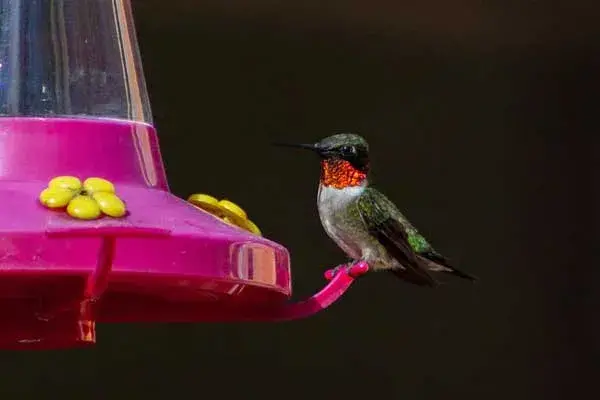
Scientific name: Archilochus colubris
Lifespan: 3-5 years
Wingspan: 3.1-4.3 in
Color: Emerald green
Range In Florida: Year-round resident in central and northern Florida; winter resident in South Florida
The ruby-throated hummingbird is one of the most common hummingbirds found in Florida.
This beautiful bird with a brilliant iridescent red throat can be seen in the central and northern parts of Florida throughout the year. During winter, it will also inhabit the southern parts of the state.
The species is sexually dimorphic which means that there is a distinct difference between males and females.
You will identify males by the metallic emerald green upperparts, grayish-white underparts, black wings, and a gorget (throat patch) of iridescent ruby red. Their tails are forked.
Females are larger than males, have slightly shorter beaks, and have white throats.
Ruby-throated hummingbirds move very quickly, around 25 mph, and will beat their wing over 50 times per second.
They only have about 940 feathers on average which is the smallest number in any bird.
These birds are mostly solitary, except during the breeding season which lasts a few days.
To attract these hummingbirds with red necks to your backyard, you can set up hummingbird feeders or plant tubular flowers. They are quite bold and might even feed at hanging plants and feeders on your porch or next to your windows!
Buff-bellied Hummingbird
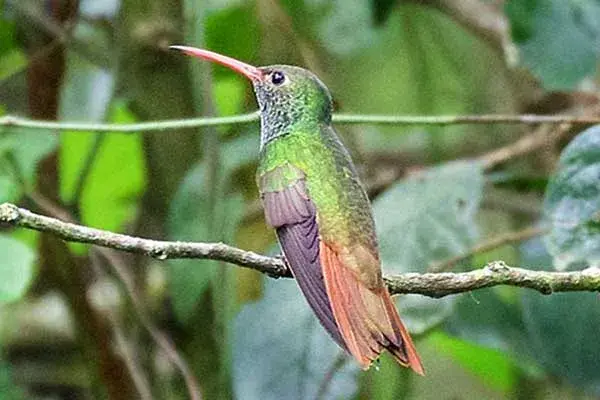
Scientific name: Amazilia yucatanensis
Lifespan: up to 11 years
Wingspan: 5.75 in
Color: Metallic olive green
Range In Florida: Vagrant visitor of West Florida
Buff-bellied hummingbirds are rare vagrant visitors along the Gulf Coast that can be seen during fall and winter in the Florida panhandle (West Florida).
These medium-sized birds are easy to identify by their metallic olive green colors, red bills, orange and slightly forked tails, and buffy patches on their bellies. They also have metallic golden green throats.
Look for them around hummingbird feeders, where they use their size advantage to chase off smaller hummingbirds. Their diet includes mostly nectar and insects.
Buff-bellied hummingbirds are partially migratory and prefer pine-oak forests, semi-arid scrub, and thickets along watercourses.
Females will build their nests in shrubs and trees to protect the eggs and both males and females will ferociously defend feeding locations within their territories. Females lay two white eggs.
Green Heron
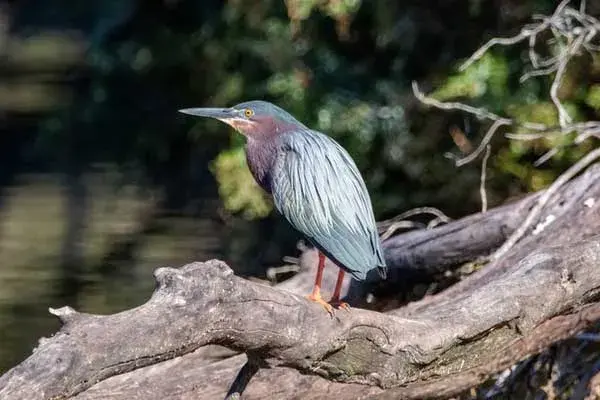
Scientific name: Butorides virescens
Lifespan: up to 8 years
Wingspan: 25-26 in
Color: Dark green
Range In Florida: Year-round resident throughout Florida
This small dark heron is a solitary bird found throughout Florida. Up close, adults have glossy greenish-black caps, dark green upperparts, gray underparts, white throats, short yellow legs, and dark long beaks.
You will also recognize them by their loud and sudden “kyow” call.
Green herons are rare birds that use tools. They will often leave bread crusts, insects, and feathers on the surface of the water to attract small fish. Then they will patiently wait for the fish to come and snatch it with their dagger-like bills.
Green herons also feed on crayfish, other crustaceans, insects, grasshoppers, frogs, rodents, and even snakes.
They can be found around small freshwater wetlands, ponds, and stream-sides lined with thick vegetation.
The American Birding Association selected the green heron as the official Bird of the Year 2015.
Budgerigar
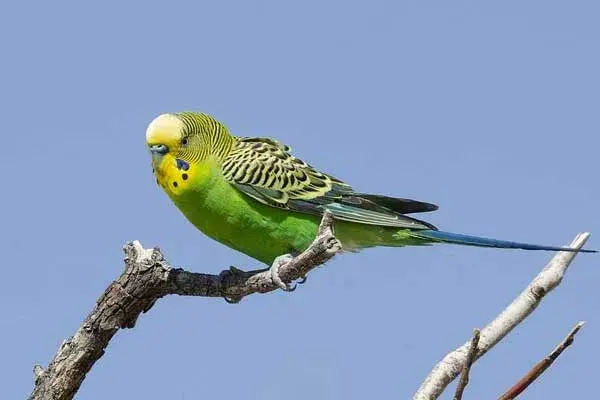
Scientific name: Melopsittacus undulatus
Lifespan: 3-6 years
Wingspan: 12 in
Color: Green-yellow
Range In Florida: Year-round resident in west-central Florida
The budgerigar, also called the common parakeet, is a small seed-eating parrot with a long tail.
The bird is nicknamed the budgie.
It is the third most popular pet in the world, right behind dogs and cats. The budgie comes in many shapes and colors; wild budgies have green-yellow plumage, with black, scalloped markings on the nape, back, and wings.
Outside of Australia, budgerigars have a large population near St. Petersburg, west-central Florida. The consistent climate conditions in Florida significantly reduced their nomadic behavior so they are now year-round residents in the state.
These yellow and green birds have a third eyelid, just like camels or llamas. They are very intelligent and can count up to three and even learn a few words.
When the breeding season comes, female budgies can gain significant weight, up to 20% more than their usual weight. This is because they retain calcium during that period.
Guess I’m not overweight, I just retain calcium, just like the budgies, ha-ha.
Monk Parakeet
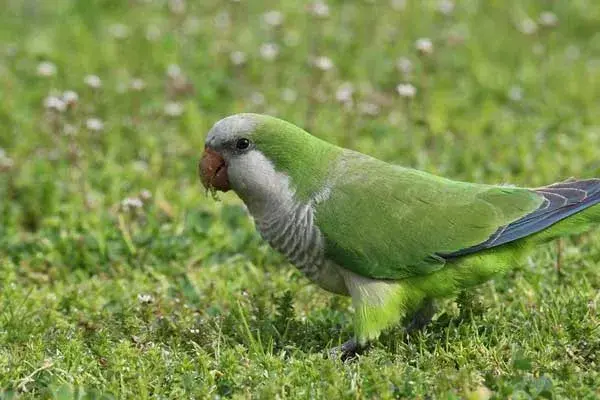
Scientific name: Myiopsitta monachus
Lifespan: 20-30 years
Wingspan: 19 in
Color: Lime green
Range In Florida: Year-round residents in central and south Florida
Monk parakeets are small, bright-green parrots that were introduced to Florida and can be now seen year-round in central and southern parts of the state. They were imported from native South America in the 1960s and 1980s and many escaped and got released in the wild.
Today, there are over 150,000 of these green birds in Florida alone.
You will identify them by large green heads, large hooked orange beaks, and long pointed tails. Monk parakeets have bright-green upperparts, greyish breasts, and greenish-yellow abdomens.
They are the only parrots that build a stick nest rather than using a hole in a tree.
Very loud and intelligent, these birds live in small flocks and feed on seeds, nuts, fruits, and greens. Many people keep them as pets due to their charming personalities and their ability to speak.
Read More: 18+ largest birds of Texas
Nanday Parakeet
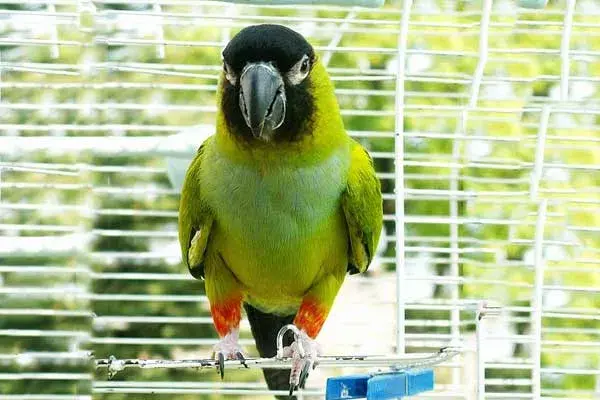
Scientific name: Aratinga nenday
Lifespan: 20 years
Wingspan: 22-24 in
Color: Green
Range In Florida: Year-round resident in central and south Florida
These medium-small mostly green birds are also known as the black-hooded parakeets or nanday conures.
Although native to South America, just like the monk parakeet, after being released in Florida, nanday parakeets have built strong populations in several areas of the state (including Pasco, Sarasota, Pinellas, Manatee, Broward, and Miami-Dade Counties).
They are quite charming parrots, mostly green with black heads and beaks, and red feathers around the thighs.
Nanday parakeets are not the quietest of birds but still make popular pets. People love them because of their intelligence, affection toward their owners, and the talent to talk and learn several words and short phrases.
Mitred Parakeet

Scientific name: Psittacara mitrata
Lifespan: 20-30 years
Wingspan: 25 in
Color: Vivid green
Range In Florida: Year-round resident in south Florida
This long-tailed green parakeet with red on the face can be seen throughout the year in Florida. If you live in the southeastern parts of the state (Miami in particular) look for them around exotic plantings in suburbs and parks.
Mitred parakeets are social birds that can be found in small flocks; in some instances, flocks of up to 2,000 of these birds may gather at roosting places.
These beautiful and affectionate birds make very popular pets – they are playful, talkative, goofy, and very smart.
Rose-ringed Parakeet
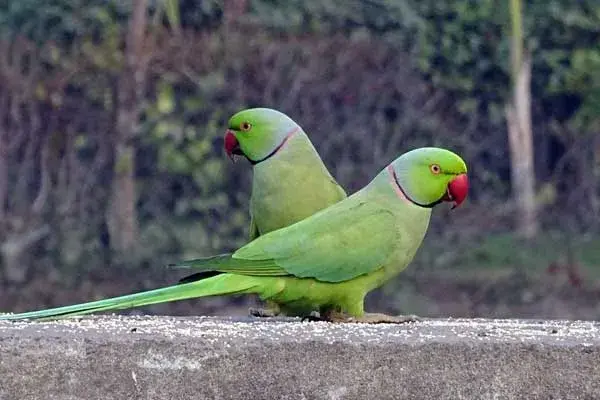
Scientific name: Psittacula krameri
Lifespan: 25-30 years
Wingspan: 16.5-18.9 in
Color: Emerald green
Range In Florida: Year-round resident in south Florida
This vibrant green parakeet is commonly found in woodland, parks, and gardens, where it feeds mainly in trees. It has a stable population in the southern parts of Florida where it can be seen throughout the year.
Easy to recognize by the stunning emerald-green plumage, red rose-ringed eyes, and a bright red beak.
In the wild, rose-ringed parakeets feed on buds, fruits, vegetables, nuts, berries, and seeds. They are even considered pests that can cause damage to farmlands and orchards.
Just like other parakeets on our list of green birds in Florida, rose-ringed ones can mimic human speech and home noises.
Green Parakeet
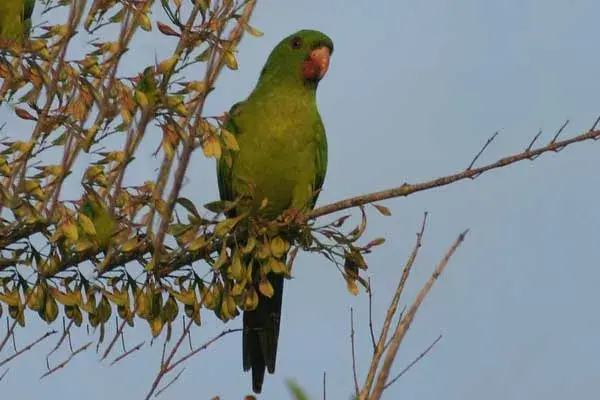
Scientific name: Psittacara holochlorus
Lifespan: 20-30 years
Wingspan: 17-19 in
Color: Bright green
Range In Florida: Year-round resident in southern Florida
One of many green-colored birds in Florida, green parakeets have an all-green bright plumage, dull pink beaks, and long pointed tails. They mostly have a uniform color, although some birds might have red speckling on their necks.
Green parakeets are medium-sized birds, very friendly and intelligent. They are easy to train and make great companions which makes them a popular pet choice.
White-winged Parakeet
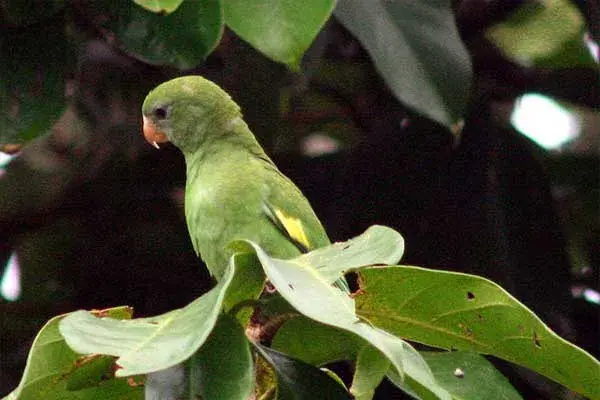
Scientific name: Brotogeris versicolurus
Lifespan: 10-15 years
Wingspan: n/a
Color: Lime green
Range In Florida: Year-round resident in south Florida
The white-winged parakeet, also known as the canary-winged parakeet, is a small parrot with a striking white-and-yellow pattern on wings, long, pointed tail, and pinkish beak and legs.
After large numbers of these green birds escaped from captivity, white-winged parakeets became a common sight around southern Florida.
All parrots in Florida were released or escaped; the only parrot native to the USA is the Carolina Parakeet which became extinct in 1918, due to hunting and habitat loss.
- Read More: Examples of Florida’s native birds
Quite affectionate towards their owners, white-winged parakeets will often ride around on shoulders or nest in the hair of their owners. And unlike some other species, there are mostly quiet birds.
Other green parrots in Florida include the blue-crowned parakeets, red-masked parakeets, white-eyed parakeets, and many more.
Ruby-crowned Kinglet

Scientific name: Regulus calendula
Lifespan: up to 5 years
Wingspan: 6.3-7.1 in
Color: Olive green
Range In Florida: Winter resident throughout Florida
Often hard to see in summer, when it lives high in tall conifers, ruby-crowned kinglet will often flit low in woods and thickets during winter. They arrive in Florida around December, so if you live in the state, this is the best time to go looking for these birds.
They are one of North America’s smallest songbirds and can be identified by their olive-green plumage with two white wing bars and white eye-rings. Male ruby-crowned kinglets also have red crown patches, which are usually concealed.
Ruby-crowned kinglets build cup-shaped nests and have the largest clutch of any North American passerine for its size. A female may lay up to 12 eggs and that entire clutch can weigh as much as the female herself.
These birds are omnivores that mainly feed on insects, some fruits, and seeds.
Ovenbird
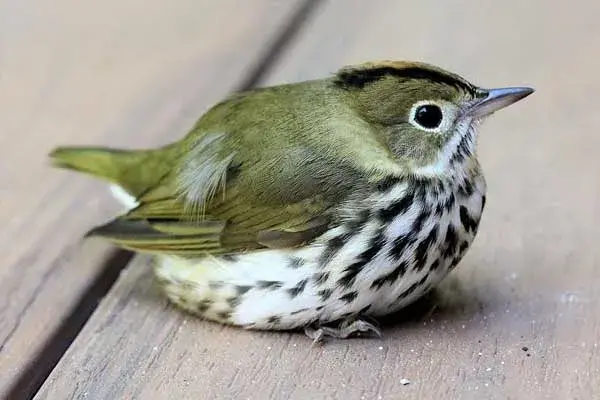
Scientific name: Seiurus aurocapilla
Lifespan: up to 11 years
Wingspan: 7.5–10.2 in
Color: Olive green above
Range In Florida: Winter resident in central and southern Florida
This small migratory bird breeds in eastern North America and spends winters in central and southern Florida, among other places.
It can be mistaken for a Wood Thrush at first glance, but it is a warbler.
Heavier in winter and particularly at the start of their migration, the ovenbird has an olive-green color on top, black and white under, a white ring around the eyes, and a black stripe below the cheek. It has dark eyes and the upper part of the thin pointed beak, a horn-colored lower beak, and pinkish legs and feet.
Ovenbird got its name from the nest it builds called the “oven” – it is a dome-like structure placed on the ground with a side entrance that makes it resemble a Dutch oven.
When a predator is nearby the nest, the female can perform a distraction display and simulate a crippled bird.
Swainson’s Warbler
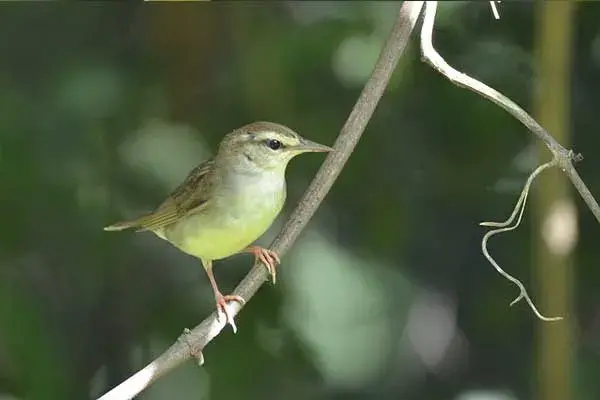
Scientific name: Limnothlypis swainsonii
Lifespan: up to 7 years
Wingspan: 9.1 in
Color: Brown-green
Range In Florida: Summer resident in western Florida
Named after William Swainson, an English ornithologist, Swainson’s warblers are solidly built songbirds with flat heads, heavy beaks, and strong legs.
Seen during summer in western parts of Florida, they have plain olive-brown color above and pale yellow-white color below. Unlike other warblers that are sexually dimorphic, there is no difference in appearance between male and female Swainson’s warblers.
Look for them in spring and summer in dense swamps and canebrakes. Swainson’s warblers are loud when their breeding season starts (March-April); they sing less frequently the rest of the year.
These birds are mostly monogamous and pairs will together defend a nesting territory.
Read More: 17+ examples of birds found in Florida with enormous beaks
Painted Bunting

Scientific name: Passerina ciris
Lifespan: 5-10 years
Wingspan: 8-9 in
Color: Bright yellow-green (in females)
Range In Florida: Winter resident in southwestern Florida and summer resident in northeastern Florida
Sometimes called the “Nonpareil”, meaning “unrivaled”, painted buntings are one of the most colorful of all US-breeding birds.
Female painted buntings usually have bright yellow-green plumage, while males are a mix of blue, red, and green.
Florida is the only state with a breeding and wintering population of these green birds. A western population of painted buntings can be found in southwestern Florida during winter; an eastern population is limited to coastal areas of northeastern Florida during summer.
Their breeding season in Florida begins in May and lasts through mid-July.
They might look cute and colorful, but painted buntings are aggressive birds. They are very territorial and will attack other males of their species.
Painted buntings are omnivores that mostly feed on seeds and insects. A group of painted buntings is known as a “mural” and a “palette”.
Read More: 15 examples of large birds found in Michigan
Wilson’s Warbler
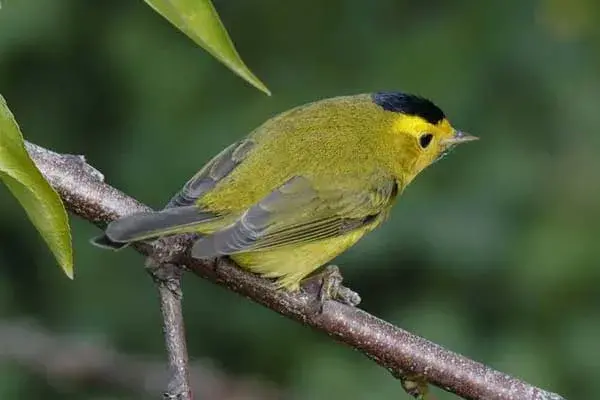
Scientific name: Cardellina pusilla
Lifespan: 6 years
Wingspan: 5.5–6.7 in
Color: Yellow-green
Range In Florida: Winter resident in southeastern Florida
This small New World warbler is greenish above and yellow below, with rounded wings and a long, slim tail.
Most Wilson’s Warblers that show up in Florida during fall and winter can be found in the southeastern portion of the state, between West Palm Beach and the everglades. Tallahassee, St. Petersburg, and Gainesville are other popular locations where this small yellow-green warbler might turn up.
The bird is named after an American ornithologist Alexander Wilson.
Males look similar to the yellow warblers – the main difference is the distinct black cap on Wilson’s warblers.
Want to learn more about Florida birds that are pink? Check this article.
Cuban Emerald
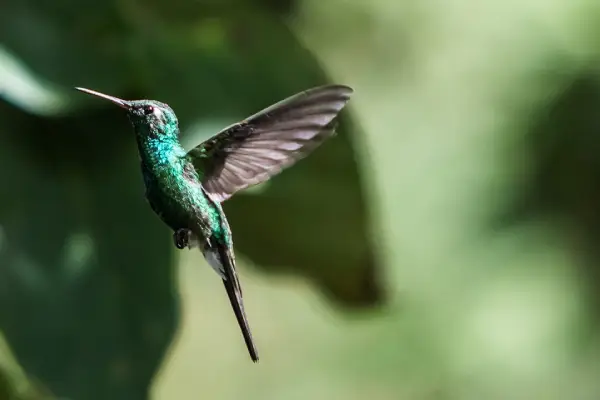
Scientific Name: Riccordia ricordii
Lifespan: n/a
Wingspan: n/a
Color: Dark green
Range In Florida: Rare
Cuban emeralds are small green hummingbirds found in Cuba and the Bahamas. They have been reported as vagrants in Florida at least 14 times.
Females are smaller than males and measure just 3.7-4.1 inches long. Males are iridescent green with red beak bases while the females are metallic green above and whitish below; both sexes have long and forked tails.
These hummingbirds are common in different wooded habitats, feeding on flowers and insects. They can be very vocal and make long series of high-pitched squeaks, buzzes, and “tsee-tsee” calls.
Read More: Examples of tiniest white birds found in Florida
Summary
This concludes our list of green birds in Florida.
There are several types of green-colored birds in Florida, including several hummingbirds, parakeets, one specie of heron, warblers, and many others.
Florida has large areas of different natural habitats that make great homes for a wide range of bird species.
Next time, should you see these birds in person, you should be able to recognize any of them with ease!
And if you enjoyed our article, here are our other popular reads on birds: 17 largest birds that live in Florida and 25 examples of green and blue birds